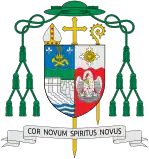Roman Catholic Diocese of San Jose (Nueva Ecija)
The Diocese of San Jose in the Philippines (Lat: Dioecesis Sancti Iosephi in Insulis Philippinis) is a Latin Church ecclesiastical territory or diocese of the Catholic Church in the Philippines.
Diocese of San Jose de Nueva Ecija Dioecesis Sancti Iosephi in Insulis Philippinis Diyosesis ng San Jose, Nueva Ecija Diocesis ti San Jose, Nueva Ecija | |
|---|---|
| Catholic | |
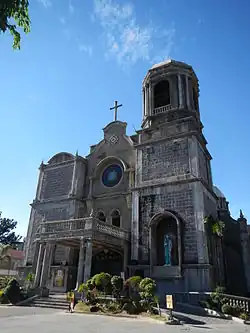 | |
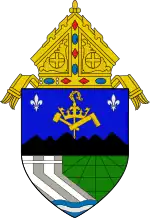 Coat of arms | |
| Location | |
| Country | Philippines |
| Territory | Northern Nueva Ecija (Carranglan, Cuyapo, Guimba, Licab, Llanera, Lupao, Muñoz, Nampicuan, Pantabangan, Quezon, Rizal, San Jose, Santo Domingo, Talugtug) |
| Ecclesiastical province | Lingayen-Dagupan |
| Metropolitan | Lingayen-Dagupan |
| Statistics | |
| Area | 2,540 km2 (980 sq mi) |
| Population - Total - Catholics | (as of 2021) 975,000 860,000[1] (88.2%) |
| Parishes | 21 |
| Congregations | 10 (4 Religious Institutes of Men and 6 Religious Institutes of Women) |
| Schools | 12 (10 Diocesan Schools and 2 Religious Administered) |
| Information | |
| Denomination | Catholic Church |
| Sui iuris church | Latin Church |
| Rite | Roman Rite |
| Established | 16 February 1984 |
| Cathedral | Cathedral-Parish of St. Joseph the Worker |
| Patron saint | Joseph the Worker |
| Secular priests | 41 |
| Current leadership | |
| Pope | Francis |
| Bishop | Roberto Calara Mallari |
| Metropolitan Archbishop | Socrates Buenaventura Villegas |
| Vicar General | Getty A. Ferrer |
| Statistics from Catholic-Hierarchy.org | |
The diocese was founded in 1984, having previously formed part of the Diocese of Cabanatuan. It is a suffragan of the Archdiocese of Lingayen-Dagupan.
The diocese held its first Diocesan Synod in March 2011 led by the Apostolic Nuncio to the Philippines. The diocese celebrated its Silver Anniversary of Canonical Erection last July 14, 2009. On April 20, Pope Benedict XVI named its third bishop, Mylo Hubert C. Vergara, as the bishop of Pasig. At present, the diocese is headed by its fourth bishop Roberto C. Mallari, former Auxiliary Bishop of the Archdiocese of San Fernando, Pampanga.
History
The Diocese of San Jose, Nueva Ecija, was created on Feb. 16, 1984 by Pope John Paul II and canonically erected on July 14, 1984. Its territory was taken from the Diocese of Cabanatuan which at same time of the division comprised the entire province of Nueva Ecija.
Sixteen parishes, out of forty one parishes of the Diocese of Cabanatuan were adjudicated to the Diocese of San Jose, Nueva Ecija. 80 percent of the people are Roman Catholics and the rest of 20 percent are members of different sects and denominations.
Bishop Florentino F. Cinense was appointed the diocese's first diocesan bishop on July 14, 1984. When appointed coadjutor bishop of Tarlac, he remained as apostolic administrator of San Jose, until the appointment of his successor Bishop Leo M. Drona on July 25, 1987. Bishop Leo M. Drona had been a Salesian of Don Bosco for twenty nine-years prior to his episcopal appointment. He is the first Filipino Salesian priest as well as the first Filipino Salesian bishop. In June 2004, Drona was transferred to the Diocese of San Pablo, Laguna as its third bishop. He was succeeded by Bishop Mylo Hubert C. Vergara, who was installed as the third bishop of the Diocese of San Jose de Nueva Ecija on May 14, 2005. Then Vergara transferred to the Diocese of Pasig. It was May 15 when Pope Benedict XVI named the current bishop, Roberto C. Mallari.[2]
Ordinaries
| Bishop | Period in Office | Coat of Arms | |
|---|---|---|---|
| 1. | Florentino Ferrer Cinense, STL | May 24, 1984 - August 17, 1985 appointed Coadjutor Bishop of Tarlac |
|
| 2. | Leo Murphy Drona, SDB | June 10, 1987 - May 14, 2004 appointed Bishop of San Pablo | 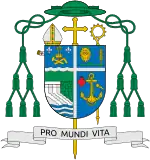 |
| 3. | Mylo Hubert C. Vergara, SThD | February 12, 2005 - April 20, 2011 appointed Bishop of Pasig | 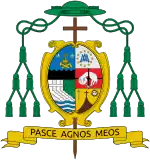 |
| 4. | Roberto C. Mallari, SSS | July 10, 2012 - present | .svg.png.webp) |
Diocesan officials
- Vicar General: Getty A. Ferrer
- Chancellor: Rufo Ramil H. Cruz
- Vice Chancellor: Vic Kevin O. Ferrer
- Oeconomous: Nestor E. Romano
- Judicial Vicar: Getty A. Ferrer
Apo Jose Catholic Educational System (ACES)
Diocesan schools
- Our Lady of the Sacred Heart College, Guimba
- St. Joseph School, San Jose City
- St. Pius X Institute, Cuyapo
- St. Pius X Institute of Nampicuan, Nampicuan
- Sacred Heart Academy, Lupao
- St. Andrew School, Pantabangan
- Holy Family Academy, Quezon
- Dominican High School, Santo Domingo
- Liceo de Christ the King, Talugtug
- St. Nicholas Academy, Carranglan
Religious administered
- San Sebastian School, Muñoz
Other educational centers
- Don Bosco Training Center, Malasin, San Jose City
References
- "San Jose de Nueva Ecija (Catholic Diocese)". gcatholic.org. Retrieved 2023-09-16.
- "Diocese of San Jose Nueva Ecija Philippines | Ucanews".
